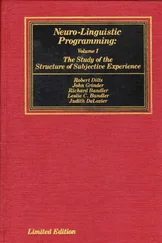All of those statements can be verified. I want you to say three sentences that can be verified, and then I want you to attach something which is not readily verifiable. You can attach any statement that is a . description of where you want them to go: "… and you're becoming more relaxed." ", . . as you continue to get more comfortable." "… and you don't know what I'm going to say next." So you make three pacing statements, use a transitional word, and add one statement that leads them in the direction you want them to go. "You are breathing, … There are sounds in the room… , You can hear people moving … and you wonder, really wonder, exactly what you're doing." Make the transitions sound as natural as possible. One of you will be the subject, and the other two will take turns saying a set of pacing and leading statements. After each of you has done two sets, I want you to begin to include descriptions of the same experience you used the first two times you did the exercise in your pacing and leading statements. "… while you take time and go back and think about when you were jogging." Notice how it's different this time.
Again, it will help if you pace nonverbally: breathe at the same rate as the person you're talking to, or use the tempo of your voice to match his breathing. And it's essential that what you say is congruent with how you say it.
When your subject appears to be into the experience as deeply or deeper than he was before, I want you to start violating these principles, one at a time. Suddenly make your voice tempo totally different. Notice whether or not that has an impact. Then go back to what you were doing before, and then change your tone. Then try not using transitions. "You're sitting there. You're comfortable. You're relaxed. You don't know what's going to happen." Notice what happens when you do that. Try adding things that are not relevant, "You can feel your fingers on the keys … and you know that there's a kitchen somewhere in this building." "You can feel your feet against the floor … and you feel the enthusiasm and interest of politicians in Washington."
Concentrate first on using all the elements that we have discussed. When you have established a good solid state, vary just one little piece and notice what happens. Then go back to using all the elements and then vary another little piece. Notice what happens to the person's face, to her breathing, to her skin color, to her lower lip size, to the movement of her eyelids. People don't talk much in trance, so you're going to have to get your feedback in other ways. If you check it out afterwards, it will be too late. You have to be able to check it out while it's going on at each moment, and the best tool to do that with is going to be your vision.
Take three or four minutes each to do this. Go ahead.
*****
Did you notice that doing the exercise this way amplified the process even more? What I have been trying to show you this morning by grading these things—by having you just do it, then giving you a little more instruction, and then having you do it again—is that I'd like you to think of hypnosis as a process of amplification. If you think of hypnosis as a way of persuading, in the end you won't be able to do nearly as much with it. If you think of it as a way of controlling, you won't be able to do nearly as much. We picked one situation in a person's experience in which she responded in a particular way, and as you used these particular techniques, you could amplify that response.
Woman: What about getting arm levitation and things like that? Is that amplification?
Hypnotists are very clever in going after responses that they know are going to happen anyway. Arm levitation is one of the things many hypnotists go for. And one of the first instructions to lead to arm lighter." Try taking a really deep breath, and notice what happens to your hands… . Your hands have a little light feeling, because when you breathe in and your chest goes up, that pulls your hands up. So if you give your instruction for light hands when the person breathes in, it will be true.
Good hypnotists pick things like that which they know will happen. However, they're not all conscious of how they're doing it. There's an old induction method you see in the movies where the hypnotist swings a watch back and forth. The hypnotist says "The watch is going back and forth slowly, and you're looking at the watch, and you see it as time passes before you. As you watch that watch go back and forth, your eyes are going to begin to grow tired." Of course they're going to grow tired! If you stare at anything long enough, your eyes will get tired.
Around the turn of the century people used to do hypnosis by having the subject look up at something. The subject would be sitting down and the hypnotist would stand up in front of her, hold up two fingers, and say "OK, I want you to stare at these two fingers, and as you look at those fingers, I want you to watch them intensely… . And as your eyes begin to feel tired, your eyelids are going to grow heavy and you'll know that you're beginning to go into a hypnotic trance." If you stare at anything that's above you long enough, your eyes are going to grow tired. "And as your eyes begin to grow tired, you begin to notice changes in the focus of your vision." If you stare at anything long enough, your focus will change. "And your eyelids are going to begin to grow heavy. You're going to feel the need to close them." Of course you will. Everyone does all the time. It's called blinking.
If I then tell you "And when your eyes close, they're going to stay shut" the odds are pretty high that they will. I've taken three pieces of verifiable experience, and I've connected them with one which is not verifiable, I've done it with a natural transition and with a flow that matches everything in your experience. I've built a step–by–step process that leads to an outcome. I'm saying "You are having this experience, and that leads to this experience, which leads to this experience" and these three are all verifiable. Your eyes are going to grow tired; your eyelids are going to want to close; your focus is going to change. You don't know consciously that those things are a natural part of experience, but as I describe them, one naturally leads to the next. Then when I add on something which is not a natural part of your experience, you are already following step by step, so you just go on to the next one. It's not that you're convinced. You never even thought about whether it was true or false. You're just following along. Using transitions like that allows you to follow along easily.
If you think of hypnosis as if it's a state of controlling someone or persuading someone, the loser is going to be you. You will limit the number of people you will be effective with. You'll also lose in your own personal life, because you're going to start worrying about who's in control of you. My experience is that people are much more respectful of themselves in hypnotic altered states than they are in the waking state. I can give someone a suggestion which is negative and harmful in the waking state, and she will be much more apt to carry it out than if she is in a trance. If you think about the things that people have told you to do which were unpleasant, but which you did anyway, you were probably in the waking state at the time you did them. In trances it's very difficult to get somebody to do something which does not lead toward something meaningful and positive. People seem to be more discerning in altered states. It's a lot easier to trick or take advantage of someone in the waking state than in any other state of consciousness I know of.
I believe that hypnosis is really biofeedback. However, a biofeedback machine does not tell you to slow your pulse down. It only tells you where it is now. You have to aim toward the outcome of your pulse being slower, or your blood pressure being different. The machine only provides the feedback. As a hypnotist you can do both. You can provide people with communications that match what's going on, just like a biofeedback machine. You can then start adding other things step by step that lead them to somewhere else, and they will be able to go along naturally and comfortably. You can create a situation in which all they have to do is respond—the one thing people do all the time, and the thing they do best.
Читать дальше











